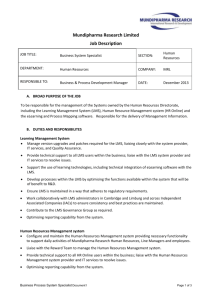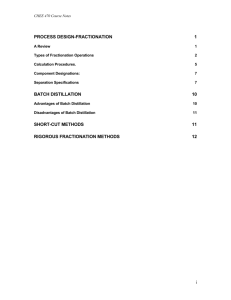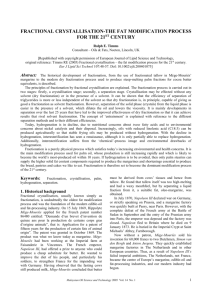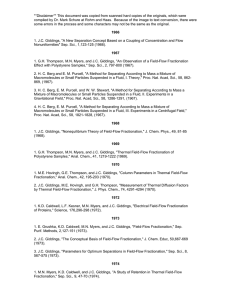plant operation theory n2 qp nov 2012
advertisement
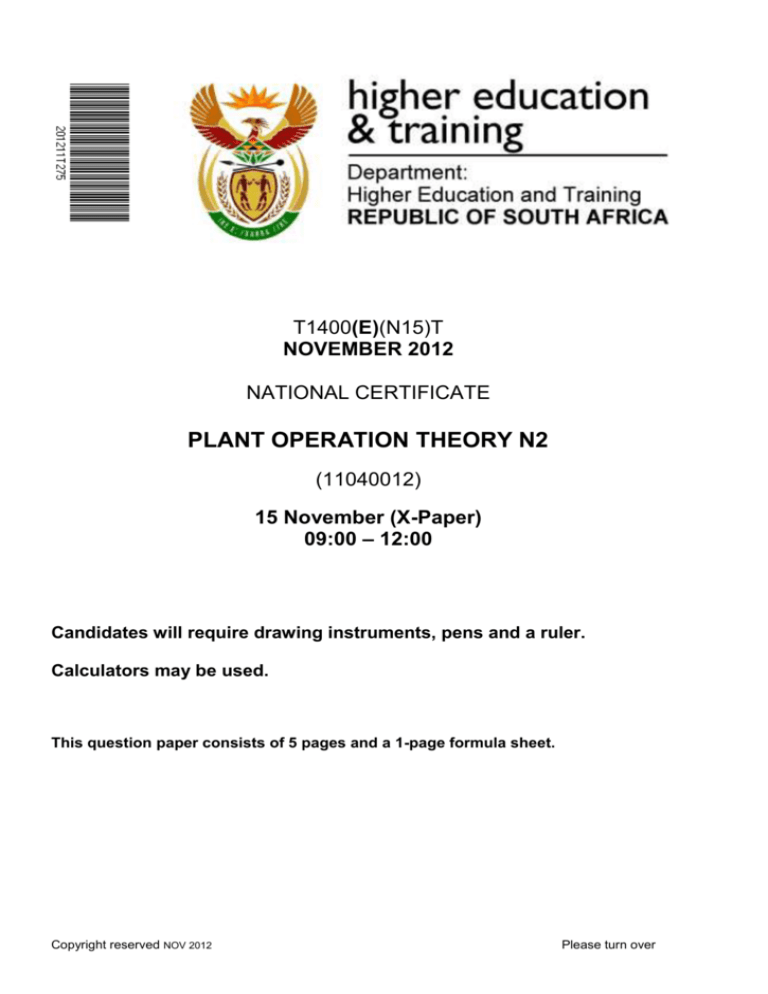
T1400(E)(N15)T NOVEMBER 2012 NATIONAL CERTIFICATE PLANT OPERATION THEORY N2 (11040012) 15 November (X-Paper) 09:00 – 12:00 Candidates will require drawing instruments, pens and a ruler. Calculators may be used. This question paper consists of 5 pages and a 1-page formula sheet. Copyright reserved NOV 2012 Please turn over (11040012) -2- T1400(E)(N15)T DEPARTMENT OF HIGHER EDUCATION AND TRAINING REPUBLIC OF SOUTH AFRICA NATIONAL CERTIFICATE PLANT OPERATION THEORY N2 TIME: 3 HOURS MARKS: 100 ________________________________________________________________________ INSTRUCTIONS AND INFORMATION 1. Answer ALL the questions. 2. Read ALL the questions carefully. 3. Number the answers correctly according to the numbering system used in this question paper. 4. Sketches must be large, neat and fully labelled. 5. 100 marks: 100% 6. Write neatly and legibly. Copyright reserved NOV 2012 Please turn over (11040012) -3- T1400(E)(N15)T QUESTION 1: CHEMISTRY 1.1 Use a diagram to explain how an electrovalent reaction takes place between TWO atoms. (7) 1.2 Give an example of a noble gas. Why is it inert or inactive? (3) 1.3 Classify hydrocarbons into groups and give the characteristic name of each group. (8) 1.4 Explain what each 2 in 2H2O indicates. (2) 1.5 Indicate whether the following statements are TRUE or FALSE. Choose the answer and write only 'true' or 'false' next to the question number (1.5.1 – 1.5.5) in the ANSWER BOOK. 1.5.1 Argon will be found in the fourth period of the periodic table. (1) 1.5.2 Three is the atom number of Li. (1) 1.5.3 CO gas is used in the Fisher Tropsch process to produce HCℓ. (1) 1.5.4 H2 is the lightest molecule in chemistry. (1) 1.5.5 NH3 is lighter than air. (1) [25] QUESTION 2: ENERGY AND FLUID FLOW 2.1 2.2 Indicate whether the following statements are TRUE or FALSE. Choose the answer and write only 'true' or 'false' next to the question number (2.1.1 – 2.1.5) in the ANSWER BOOK. 2.1.1 Power refers to the work done per distance. (1) 2.1.2 A watt is one joule of work done per sixty seconds. (1) 2.1.3 Pressure will not influence the viscosity of a fluid. (1) 2.1.4 Hydraulic gradient refers to the mass of a fluid per unit volume. (1) 2.1.5 Laminar flow in a pipe refers to flow in layers. (1) Define the following: 2.2.1 2.2.2 2.2.3 Heat One joule Matter Copyright reserved NOV 2012 (3) (2) (3) Please turn over (11040012) -4- T1400(E)(N15)T 2.3 Explain the effects of heat on a substance. 2.4 Discuss the following factors which cause loss of pressure in pipes: 2.4.1 2.4.2 2.5 (4) Viscosity of the liquid Density of the liquid (3) (2) Draw a graph to indicate how the loss of pressure in pipes is affected by the diameter of the pipes. (3) [25] QUESTION 3: DISTILLATION AND FRACTIONATION 3.1 Indicate whether the following statements are TRUE or FALSE. Choose the answer and write only 'true' or 'false' next to the question number (3.1.1 – 3.1.5) in the ANSWER BOOK. 3.1.1 3.1.2 3.1.3 3.1.4 3.1.5 The separation of components of liquid mixture through stages of heating and cooling refers to the stripping section of a distillation tower. (1) The heat balance and the composition of the feed determine the effect temperature gradient of a distillation tower. (1) One reason that causes an operational problem at fractionation towers is variation in the feed temperature. (1) Pressure plays an important roll in the stripping section if the bottom product is more important than the overhead product during distillation. (1) Packed towers are not recognising as a type of fractionation towers. (1) 3.2 Explain partial evaporation and partial condensation. (4) 3.3 Give reasons why the fluid level in the down pipe of a fractionation towers will rise during fractionation. (4) 3.4 Briefly explain, with the aid of a fully labelled sketch, when bottom pressure control is applied for heat balancing. Accept that a steam re-boiler is in use at the bottom of the tower. Copyright reserved NOV 2012 Please turn over (12) [25] (11040012) -5- T1400(E)(N15)T QUESTION 4: INSTRUMENTATION 4.1 Indicate whether the following statements are TRUE or FALSE. Choose the answer and write only 'true' or 'false' next to the question number (4.1.1 – 4.1.5) in the ANSWER BOOK. 4.1.1 Pascal = Newton per m3. (1) 4.1.2 270 K = –3 °C. (1) 4.1.3 An indicating element refers to the primary measuring element. (1) 4.1.4 A dead mass tester functions on the principles of Pascal’s law. (1) 4.1.5 The principal of metal expansion can be used to measure a steam drum level. (1) 4.2 Explain the most important requirement for effective control of any process. (3) 4.3 State the relative advantages and disadvantages of venturi tubes. (7) 4.4 Explain the principle of operation of rotameter flow meters. (4) 4.5 Sketch a dead-weight tester for meters. (6) [25] TOTAL: Copyright reserved NOV 2012 Please turn over 100 (11040012) -6- T1400(E)(N15)T PLANT OPERATION THEORY N2 Copyright reserved NOV 2012 Please turn over





